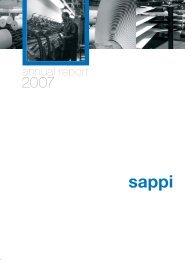2012 Integrated report - Sappi
2012 Integrated report - Sappi
2012 Integrated report - Sappi
You also want an ePaper? Increase the reach of your titles
YUMPU automatically turns print PDFs into web optimized ePapers that Google loves.
Notes to the group annual financial statements<br />
for the year ended September <strong>2012</strong><br />
29.2 Financial instruments continued<br />
Hedge accounting continued<br />
3. Net investment hedges continued<br />
Commodity price risk<br />
Commodity price risk arises mainly from price volatility and threats to security of raw material supply and other inputs to the<br />
production process.<br />
A combination of contract and spot deals are used to manage price volatility and contain costs. Contracts are limited to the group’s own<br />
use requirements. The group aims to improve its understanding of the direction, magnitude and duration of future commodity price<br />
changes and to develop commodity specific expertise.<br />
The pulp swaps contracted in 2010 matured in January 2011 and no other pulp swaps have been contracted during fiscal <strong>2012</strong>.<br />
b) Liquidity risk<br />
Liquidity risk is the risk that the group will be unable to meet its current and future financial obligations as they fall due.<br />
The group’s objective is to manage its liquidity risk by:<br />
• managing its bank balances, cash concentration methods and cash flows;<br />
• managing its working capital and capital expenditure;<br />
• ensuring the availability of a minimum amount of short-term borrowing facilities at all times, to meet any unexpected funding<br />
requirements; and<br />
• ensuring appropriate long-term funding is in place to support the group’s long-term strategy.<br />
Details of the group’s borrowings, including the maturity profile thereof, as well as the group’s committed and uncommitted facilities are<br />
set out in note 20.<br />
The group is in compliance with all material financial covenants applicable to its borrowing facilities.<br />
Liquidity risk management<br />
US$ million<br />
September <strong>2012</strong><br />
Total<br />
financial<br />
assets<br />
and<br />
liabilities (1)<br />
Fair value<br />
of financial<br />
instruments<br />
0 – 6<br />
months<br />
6 – 12<br />
months<br />
Undiscounted cash flows<br />
1 – 2<br />
years<br />
2 – 5<br />
years > 5 years Total<br />
Financial assets<br />
Other non-current assets 22 22 12 – – 4 7 23<br />
Non-current derivative<br />
financial assets 22 22 3 3 7 12 – 25<br />
Receive leg 12 11 23 47 – 93<br />
Pay leg (9) (8) (16) (35) – (68)<br />
Trade and other receivables 723 723 722 1 – – – 723<br />
Current derivative financial<br />
assets – – – – – – – –<br />
Receive leg 60 – – – – 60<br />
Pay leg (60) – – – – (60)<br />
Cash and cash equivalents 645 645 645 – – – – 645<br />
1,382 4 7 16 7 1,416<br />
Financial liabilities<br />
Interest-bearing borrowings 2,358 2,282 69 69 588 1,118 1,607 3,451<br />
Non-current derivative<br />
financial liabilities 46 46 2 1 2 18 11 34<br />
Pay leg 33 32 62 595 361 1,083<br />
Receive leg (31) (31) (60) (577) (350) (1,049)<br />
Other non-current liabilities 1 1 – – 1 1 – 2<br />
Interest-bearing borrowings 261 270 140 137 – – – 277<br />
Overdraft 5 5 5 – – – – 5<br />
Current derivative financial<br />
liabilities 1 1 – – – – – –<br />
Pay leg 157 22 – – – 179<br />
Receive leg (157) (22) – – – (179)<br />
Trade and other payables 784 784 746 – – – – 746<br />
962 207 591 1,137 1,618 4,515<br />
Liquidity surplus (gap) 420 (203) (584) (1,121) (1,611) (3,099)<br />
(1) Refers to items that are in scope in terms of IAS 39 Financial Instruments: Recognition and Measurement.<br />
164
















